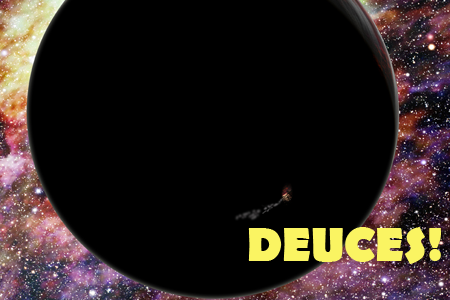Hypervelocity Planets Are Leaving Our Galaxy At Warp Speed. PEACE.
These planets have the balls-out ride of the cosmos. After getting too close to the supermassive black hole at the center of our galaxy, they’ve been flung the fuck out of the galaxy. Beasted!
io9:
The wildest ride in the galaxy is found on hypervelocity planets. These worlds got too close to the supermassive black hole at the center of our galaxy, and have been flung away at a twentieth of the speed of light.
While rogue planets are common enough, these hypervelocity planets represent a much rarer case and can only be formed by a star system – specifically, a double star system – coming into contact with Sagittarius-A*, our galaxy’s central supermassive black hole. Previous research has indicated that when a binary star system gets too close to Sagittarius-A*, it’s possible the system to be ripped apart, with one star entering orbit around the black hole while the other is ejected at enormous speeds.
Now researchers at the Harvard-Smithsonian Center for Astrophysics say the same phenomenon could work for any planets orbiting these double stars. Let’s imagine a simple example of such a solar system, with Star A and Star B. In this system, Planet A primarily orbits Star A and Planet B primarily orbits Star B. As the binary comes into contact with Sagittarius-A*, Star A goes into orbit while Star B is ejected, zooming on a trajectory that will take it out of the Milky Way at millions of miles per hour.
So then, what happens to Planet A and Planet B? As long as Planet B is in very close orbit around Star B, it will go along for the ride. The fact that such planets must be close to their planets to come along at all is good news for astronomers looking for them, as it means the odds of spotting a hypervelocity planet in transit around its star – assuming it actually exists in the first place – is about 50%. Obviously, there’s no guarantee the planet is there to begin with, but the odds are good that if it is there, we won’t miss it.
The even more interesting case is the fate of Planet A. Instead of joining its star in orbit around Sagittarius-A*, it too is torn out of its old orbit and sent flying into the cold reaches of space. These hypervelocity planets are like the dark world in the artist’s conception up top, where plate tectonics – as demonstrated by that lone volcano – are the only thing providing the starless planet any warmth.
According to the astronomers’ simulations, these hypervelocity planets would typically reach speeds of 7 to 10 million miles per hour. The fastest ones could get all the way up to 30 million miles per hour, about a twentieth of the speed of light. As lead author and Dartmouth astrophysicist Idan Ginsburg points out, only subatomic particles are moving out of our galaxy at faster speeds.
Yeah, they ain’t up to nothing much. Just rocketing out of our galaxy at 7 million miles a friggin’ hour.




